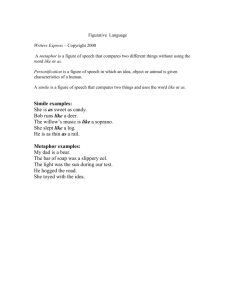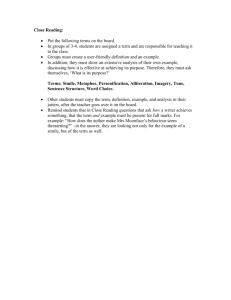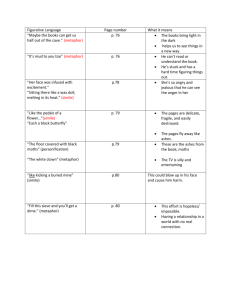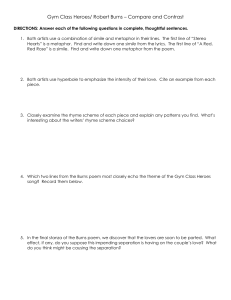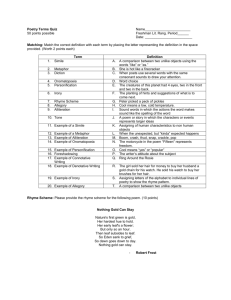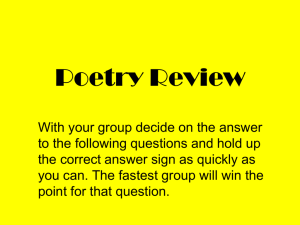Presentation1
advertisement
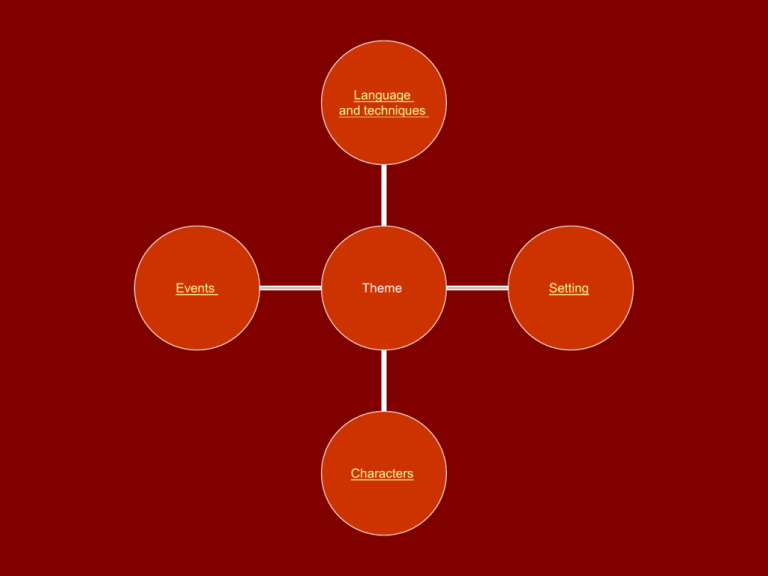
Language and techniques Events Theme Characters Setting All the different short texts that we can analyse in this way • Miss Brill • Requiem in a townhouse • Decent of the flugelhorn • Mr Van Gogh • Yellow Brick Rd • Return to Oz • The Doll’s House • Cowpats • Pause • Response • Stopping by the woods on a snowy evening • The road not taken • No Ordinary sun • The Old place • The wall • Mending wall • Nothing gold can stay Language and techniques Home Syntax Poetry features Motif More poetic features Metaphor Simile Allusion Symbolism Metaphor questions A. B. What is a metaphor? Identify three metaphors from the text (For each metaphor answer the below questions) • What is the subject of the metaphor? • What is the subject being compared to? • Why do you think the author thought this was a clever comparison? • What image comes to mind when you read this metaphor? • Is it a positive or negative image • Why do you think the author chose to include this image within the story? • How does the image add to the message? Home A metaphor is… A comparison between two dissimilar things without using like or as. Abstract feelings can be one of the things, eg love is a rose, or you could use a two concrete objects, eg he is a monster. The subject is the thing being described. A positive metaphor is demonstrative of a positive attitude towards the subject from the author. Metaphor questions Events Throughout every text there are moments that stand out as they seem to highlight information about character and/or theme. Our job as critical analysists we have to figure out what the epiphany or lesson is. Remember that we have to ask why writers of short text have added certain lines, words and phrases. So… Important moments questions Identify three important moments that you think provide information about the writers’ purpose and/or the stories’ characters. (For each moment answer the below questions) • • • • • • • • • • Identify who is involved in the event? What is the problem that the characters have to overcome? How do they over come the problem? What do we learn about the character from their reaction to the problem? Do you think that the right decision was made? How do you think the author feels about the choice? Do you believe that the problem faced by the character is reflective of society? What have we learnt about how society treats each other? What lesson can be derived from this event? Is there a pattern in relation to theme or is there more than one theme? Home Setting 1. 2. What are the different components of setting? Where did the story occur? Was there more than one setting? 1. 3. 4. 5. 6. How did the place dictate the behaviour of the characters? What were the clues to which country the story was set in? What was the social and economic situation for the characters? How did this dictate the way they behaved and how they were treated? When did the story occur? Or when was it written? 1. 2. 3. 4. 7. If there was more than one setting how did the two places differ in relation to the language used to refer to it? What do you know about this time period? How was this evident within the story? What differences could you identify between then and now? What issues were prevalent at the time? How does the story make a comment about the society? Home Characters (Fill in the table below) Name Best quality Motivation (include proof) Problems Best quote (include why the quote is his/her best) Home More character work For each character complete these questions 1. 2. 3. What do I think of myself? What do those I am with think of me? What are the three most important things that I choose to do? Are these good choices, and what do they tell the reader about me? What are the three most important things that I say? What does the reader think of me? 4. 5. • 6. 7. 8. How does the author manipulate the reader? What do I value? Are these good values? What are my strengths and my weaknesses? What is the most interesting thing about me? Write a paragraph about me that sums up why I am important in delivering the authors message. Home Minor Characters For three minor characters complete these questions 1. 2. 3. 4. 5. 6. 7. 8. What do I think of myself? What do those I am with think of me? What are the three most important things that I choose to do? Are these good choices, and what do they tell the reader about me? What are the three most important things that I say? What does the reader think of me? • How does the author manipulate the reader? What do I value? Are these good values? What are my strengths and my weaknesses? What is the most interesting thing about me? Write a paragraph about me that sums up why I am important in delivering the authors message. Home A simile is… A comparison between two dissimilar things using ‘like’ or ‘as’. “My love is like a Rose” or “He is as big as a giant”. Like metaphor if the subject is compared to a negative object then the simile creates a negative tone. Simile questions Home Simile questions Identify three similes from the text. • For each simile answer the below questions) – What is the subject of the simile? – What is the subject being compared to? – Why do you think the author thought this was a clever comparison? – What image comes to mind when you read this simile? – Is it a positive or negative image – Why do you think the author chose to include this image within the story? – How does the image add to the message Home Tone Tone is the atmosphere or mood of the text. The tone generally reflects or creates a clue in regards to the authors attitude to the subject or characters in the text. When reading short text the best idea is to find the tone first. Next Tone work Each line of a poem, each paragraph of a story • What is the subject • Highlight the emotive words • Identify the author’s mood • Identify any language feature that you have highlighted • Identify any patterns – Has the writer used a feature more than once – Is there any change of mood – Is there any reason why the mood changes – What is the overall mood of the author Home Allusion is … Referring to other figures or forms of literature within a piece of literature. (Very Post-Modern) It is done to hint at the idea that the writer is trying to impress upon the reader. Questions Allusion questions 1. 2. What or who is being alluded to within the text? What do you know about the subject being referred to? i. ii. 3. What was the subject known for? What did the subject stand for? How do you think the allusion raises the thematic concern of the piece of writing? Home Syntax This is the sentence construction. You need to understand that writing is a craft and that poets and short story writers use sentences to form the pace and tone of their writing. Syntax is just as important to the writer as semantics. Sentence types Home Semantics Think hip hop stars from New Zealand. The ‘ill semantics’. Or, in a colloquial manner, one Mr E is not too good with ‘Sick words my homey brother’. Semantics is the choice of word. See diction Diction This is the register of the language. High register language is very proper, very ‘highly’ educated Low register language is very poorly or ‘lowly’ educated When you write an essay or talk to any teacher it is expected that you use high register language Slang (swearing, street talk, sports field) and colloquial (conversational with a mate) is low Syntax Sentence types There are many different types of sentences Simple Complex Compound Compound – complex Incomplete Balanced Periodic Minor Clauses are also important to understand, Try to investigate parenthesis too! You have been taught these over the last few years, please take the time to refresh your memory. Definitions available on the e-coll site Miss Brill Stylistic features Events Theme - Mistreatment of elderly - Of the different - Appearance v reality Characters Setting Commonly used features of short text • • • • • • • Personification Symbolism Repetition Enjambment Alliteration Assonance Sibilance • • • • • • • Heroic couplet End pause Meter or Rhythm Pun Oxymoron Onomatopoeia Rhyme Home Personification is … A form of metaphor in which something nonhuman is associated with or given human characteristics, eg ‘Slowly, silently now the moon/walks the night in her silver shawl’. Here the object takes on a human characteristic Home Symbolism is … When an object or image represents a central and universal idea. The ‘Golden Arches’ no more just represent American fast food, now they represent the American capitalist regime built on the sins of gluttony and greed. Home Questions Repetition is … Repetition is … Repetition is … When poets repeat a word or phrase or even an image to reinforce the central idea within a text. The effect of this is that it will stick in the mind of the reader or the listener and develop the tone. Home Enjambment is … When a poet does not put any punctuation at the end of a line so that it runs into the next line; usually with an inflective pause. It creates fluidity within the poem. Home Alliteration is … The repetitive consonant sound at the beginning of a series of words. Christmas crackers crackled at the consumption of the crackling. Note that the consonant sound within the words is not underlined; that is consonance Home Assonance is … The repetition of the vowel sound within the word. The racoon was a hoon The silly loon attacked a broom Or Look who took the book The ‘o’ in who does not fit the vowel sound Home Assonance creates Rhyme It is also good for long drawn out slow periods of speech, and can create flow in the text. This is unlike alliteration which is jumpier Home Sibilance is … Consonance of ‘s’ sounds, eg ‘the grass rustled in the breeze’ The effect of this is either to soften the tone or to make it a harsh spitting sound Home Heroic couplet is … A pair of rhymed lines, often used by Shakespeare and other poets at the end of a speech (and his sonnets), in order to convey something important. Home End pause is … When the line of poetry ends some punctuation. This creates a natural pause which places emphasis on the following line as the reader is made to wait Home Meter or Rhythm The natural beat created by the words. The rhythmic pattern which emerges when the stressed and unstressed syllables fall into a more or less regular sequence is called meter. The basic unit of metre is a group of two or three syllables called a foot. Home Forms of Meter Iambic (unstressed - stressed) x / x / x / x / x / The curfew tolls the knell of parting day. Trochaic (stressed – unstressed) / x / x / x / x Through the shadows and the sunshine Dactylic (stressed – unstressed – unstressed) / x x / x x / x x / xx Dactylic daintiness, lilting so prettily Anapestic (unstressed – unstressed – stressed) x x / x x / x x / x x / And the sheen of their spears was like stars on the sea Home Labels for the number of feet in a line: monometer dimeter trimeter tetrameter pentameter hexameter one foot two feet three feet four feet five feet six feet This is one of the great mathematical theories that the Da Vinci code touched on. Home Pun is … A play on words in a witty manner. Such as “Electricity. A shocking way to go!” Home Oxymoron is … The juxtaposition of two antonyms to reinforce the second words meaning. Such as… Pretty Ugly Home Onomatopoeia…get it? Home Rhyme Now is the time for rhyme The rhyme scheme here is aa. A rhyme scheme maps out the rhyme within the poem and shows the pattern. A jumbled up rhyme scheme shows indecision, while a tight one will lead you to a point. If there is a change in rhyme scheme that is a pretty good hint that the main point is close by Home Symbolism questions When a writer focuses in on a seemingly insignificant object that item is usually a symbol. 1. 2. 3. 4. 5. 6. 7. 8. Which items or images does the writer focus in on? What are these items or images usually related to? Are the items glorified or denigrated? Are any of the items or images repeated? What is the idea of the text? How does incorporating this item or image help reinforce the main idea? Are there any characters from the text that might be especially connected with the image? How would it effect the story if the item or image was not incorporated? Symbolism def Complete this table for each term or feature of short story Statement Example Xplain Discuss Technique Example Explain Discuss Symbol Simile Rhyme Metaphor Repetition Rhythm Own choice

